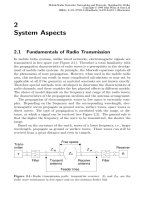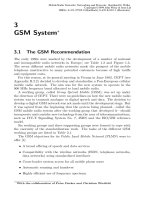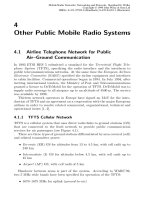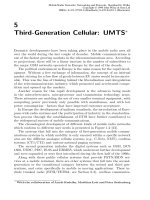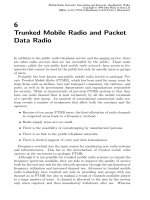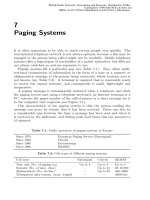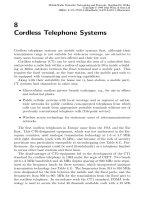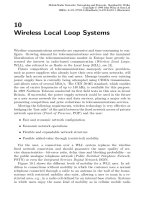Tài liệu Điện thoại di động băng thông rộng không dây P6 pdf
Bạn đang xem bản rút gọn của tài liệu. Xem và tải ngay bản đầy đủ của tài liệu tại đây (3.2 MB, 20 trang )
4
Emerging Wireless Applications
and Protocols
4.1 Introduction
Two drivers have taken the market by surprise in recent years: wireless is the first and the
second is the Internet and Internet technology. At the end of 1998 there were around 260
million wireless mobile users and growth continues at over ten million new subscribers per
month. The latest forecast figures by Delson Group indicate that the total number of wireless
cellular subscribers world-wide will reach two billion by 2005.
Convergence of wireless and Internet will be one of the hottest topics in the coming years.
Wireless Mobile Internet (or WMI) and its devices are coming to the market in ever increas-
ing numbers all over the world. The investment in this business will be over 100 billion
dollars within the next several years.
The various sectors of the industry have also been active on the standards front and in the
creation of alliances and forums that will carry the momentum forward. The WAP Forum and
the WAP (Wireless Application Protocol) standards are particularly significant since this
industry standard insulates the Internet-based application from the wireless mobile network
infrastructure. Thus, content (service and application) can now be decoupled from delivery
(bear network). This allows the applications to run over wireless mobile networks, both
current and future, thereby creating a massive new global market for wireless value-added
services.
Wireless mobile users will not just want to access all the information that is available on
the Internet via a phone. It therefore makes better sense if the operator selects an appropriate
service portfolio that is tailored to mobile subscribers. It is also impractical to deliver the
content to a phone in the same manner as that supplied to a PC. The graphics and hyperlinks
need to be stripped out, but this only represents a Band-Aid approach to the problem. What’s
needed is a wireless equivalent to the WWW, which is where the WAP comes into the
picture.
WAP is an industry standard that allows software developers to create content suitable for
display on ‘smart’ mobile phones. They write their service according to the WAP specifica-
tion and it can then be delivered over any mobile network. Developers do not need to know
Broadband Wireless Mobile: 3G and Beyond. Edited by Willie W. Lu
Copyright
2002 John Wiley & Sons, Ltd.
ISBN: 0-471-48661-2
anything about the delivery process and writing WAP-compliant applications is very similar
to creating WWW content.
Therefore, WAP hides the complexity of wireless networks, both current and future, at the
application layer. This means that it is very easy to develop lightweight Internet applications
that will run on the new wireless information devices.
In addition to the WAP standards, there are also several other solutions available in the
market, for example, iMode and wJAVA (wireless JAVA). If anyone has any doubt about the
potential of wireless Internet, they need only look at the iMode service provided by the
Japanese service provider NTT DoCoMo. In only about 15 months, DoCoMo built its
iMode service into a popular wireless experience serving nearly 10 million users.
Currently, a large amount of information exists in the Internet that can meet very diverse
needs. This is clearly a good match for mobile wireless users while travelling from place to
place. It has been projected that most handsets will be equipped with WAP and Wireless Java
in a few years for wireless Internet applications. When Internet information can be delivered
wirelessly according to handset geolocation information, it becomes even more valuable and
convenient.
4.2 Wireless Application Protocol (WAP)
The significance of WAP goes far beyond merely superposing the Internet on wireless
networks. The WAP business will be one of the next storms in the coming years.
4.2.1 WAP Markets
Why is the WAP so important? It is driven by the huge wireless mobile market as well as the
Internet infrastructure. From Figure 4.1, the number of mobile phones will reach around 1.3
billion by 2004, and most of the phones will be WAP equipped.
The importance of WAP is reflected in the following statements:
† Mobile will make the Internet ubiquitous. Most of the applications are things that we
already do – the industry’s task is to convert a share of our use onto wireless Internet.
Broadband Wireless Mobile: 3G and Beyond240
Figure 4.1 Worldwide Internet subscribers, 1999–2004 by IDC.
† Wireless Internet is a strategic imperative. Operators must provide these services to avoid
revenue and profit erosion.
† WAP is a key building block for wireless Internet.WAP has received huge industry back-
ing; it opens the market to new players.
Therefore, the wireless Internet will be big and WAP will be a main contender (see Figure
4.2 by OVUM).
By March 2001, over 40 million WAP devices had been shipped worldwide (Figure 4.3),
and thousands of applications are already available in the market including (but not limited
to):
† M-commerce – shopping, ticket purchases, reservations, comparison shopping
† Finance – statements, funds transfer, shares trading
† M-billing – notification, presentation and payment of bills
† Enterprise access – inventory, shipment/sales updates, email access
† M-care – customer service, payment status, other backroom operations
† Entertainment – games, gambling, interactive multi-player events
† Messaging – communication and collaboration
† Travel – scheduling, advisories, reservations
† Location-smart services – traffic reports, parking information, store discounts, event
recommendations
In the global market:
† Over 150 carriers deployed or in final testing of WAP.
† Tens of thousands of developers are now creating applications and contents.
Emerging Wireless Applications and Protocols 241
Figure 4.2 Wireless Internet and WAP Market (source: OVUM).
† Over 12,000 WAP sites are available from 100 countries.
† Over 5 million WAP-readable pages available.
† Over 40 million WAP-enabled handsets are in circulation worldwide.
As shown in Figure 4.2, the revenue from WAP-like active micro-browser users is growing
very fast (Figure 4.4). By 2005, it will reach over $300 billions.
In a word, WAP is an application tool towards wireless Internet that meets:
Broadband Wireless Mobile: 3G and Beyond242
Figure 4.3 WAP devices worldwide (Source: WAP Forum).
Figure 4.4 Revenue from Active Micro-Browser Users (source: OVUM).
† anytime, any place and anywhere access
† more mobile terminal users than PC users
† mobile terminals are personal devices
However, the key success factors for WAP depend on the followings:
† service marketing
† price
† time to access service
† overall user experience and service design
4.2.2 WAP Architectures and Protocols
The focus of WAP is to bring mobile data to the mass market. The way of providing this is to
map internet-type applications plus telephony-specific features onto wireless requirements.
Internet pages known from the fixed network will be processed by compressing information
and representing this in so-called ‘cards’ on the handset display. A very important advantage
of WAP is that it aims to provide standardised support for wireless data applications. So each
handset developed according to the WAP standard is able to support WAP-based applications
in the whole network.
With this technology in place, a new information service can simply be developed as a web
site and then viewed on the screen of the phone.
4.2.2.1 What is WAP?
WAP is the set of technical standards that enables users of wireless devices to access, and
receive content from the Internet with:
† open, non-proprietary
† global
† device independent
† bearer independent
† a full-fledged Internet citizen
WAP is a standard developed by consensus from engineers, scientists, specialists and
experts from over 500 companies all around the world. It adopts Internet protocol to the
requirements of the wireless networks (see Figure 4.5).
WAP also opens the world of mobile data services, for example, it brings mobile data to the
mass market, Internet-type applications plus telephony-specific features as well as providing
standardised support for wireless data applications.
WAP is also applicable to many different wireless beares and infrastructures (see Figures
4.6 and 4.7).
The major WAP units and functions include:
WAP gateway
† serves as proxy
† provides protocol mapping between standard and WAP protocol
Emerging Wireless Applications and Protocols 243
† provides encoding/decoding for efficient transfer of data
† provides access to mobile data bearers
WAP servers
† supports standard Internet protocols
† provides application contents and scripts in WAP-specific or standard Internet formats
Broadband Wireless Mobile: 3G and Beyond244
Figure 4.5 WAP overview (source: Siemens).
Figure 4.6 WAP applicable to many wireless beares (source: Siemens).
WAP clients
† supports WAP protocol stack
† provides encoding/decoding
† enables browsing of WAP contents
† enables user intersection
† supports intersection with SIM
WTA Server
† located within secure network operator domain
† communicates with client via gateway
† able to ‘Push’ WAP contents to WAP client
† Figure 4.8 shows this structure.
4.2.2.2 WAP Roadmap
The goal of WAP forum is to make the mobile device a first class citizen of the web. WAP
fills a unique role of:
† intersection of mobile/web/Internet
† wireless industry focal point, for example, requirements, ideas, design and development as
well as interoperability
† collaborator with key web/Internet groups, for example, technical development, advisor
on wireless capabilities and requirements
† industry forum for multi-vendor interoperability
The WAP roadmap is shown in Figure 4.9. The focus includes the following.
Emerging Wireless Applications and Protocols 245
Figure 4.7 WAP infrastructure (source: Siemens).
Bandwidth
Adaptation and evolution of the protocol suite:
† 2.5G and 3G bearers:
† convergence with IP environment (for example, TCP, TLS, …).
Creation of new services, enabled by bandwidth:
† streaming media
† larger data types (for example, animations)
Broadband Wireless Mobile: 3G and Beyond246
Figure 4.8 WAP units and functions (source: Siemens).
Figure 4.9 WAP Roadmap.
Convergence
Collaboration with IETF, W3C and others:
† to define a common Internet framework
† suitable for mobile and fixed devices
Never ending process:
† WAP 1.X leveraged HTTP, XML, URLs and the web
† WAP 2.X will expand to leverage XHTML, TCP, etc.
Joint work in the past includes:
† XHTML-basic
† CC/PP/UAProf [ ]
Future work:
† protocol optimisations (for example, TLS, HTTP, TCP)
† application models (for example, voice, multi-mode UI)
Multimedia
Mutimedia services enabled by:
† more bandwidth (GPRS, 3G, etc)
† Moore’s law and handset evolution
† imaging – colour, standard formats, etc.
† audio – download clips, streaming, etc.
† video – download clips, streaming, etc.
† streaming protocols
† longer term, QoS and isochronous protocols
Advanced user-interface
Handset evolution drives requirements:
† pixel resolution, density and colour
† new input models (voice, pointers, security sense, etc.)
Application model enhancements:
† styling model
† document model
† advanced script integration
† voice interface
† muti-mode user interface
Application services
Additional application services enabled by terminal and network capabilities with Web-
enabling unique wireless features:
Emerging Wireless Applications and Protocols 247
† terminal location
† push
† commerce capabilities
† messaging
Management services
Services targeted at network operator:
† provisioning
† terminal monitoring
† terminal management
4.2.2.3 WAP Traffic Model
The WAP traffic model takes into account a couple of input parameters like:
† user behaviour (WAP usage time, BH portion, view time, etc)
† different applications and their usage
† application characteristics (transactions, bandwidth volume)
And provide us the information about:
† traffic per use
† overall bandwidth demand (upstream/downstream)
† number of transactions to WAP devices (NetServer, firewall, WAP server, WAP gateway)
Figure 4.10 shows a simple WAP traffic model.
The WAP traffic model is only for general-purpose analysis of the WAP performance, and
should not be taken as a standard model in different applications and services.
4.2.2.4 WAP and XML
XML is a framework for markup languages, but not a markup language itself. WAP is the
only wireless Internet protocol that is built on XML. Therefore, XML is a platform technol-
ogy, not a presentation language. XML allows content to be published one time, but can be
used many times. However, WML (the core markup language of WAP) is designed for
presentation.
The background of XML is:
† XML is a platform technology:
– Basis for many markup languages: SMIL, MathML, WML, XHTML, VoiceXML, etc.
– Basis for much application middleware and protocols.
† XML is not a presentation language like HTML.
† W3C has based a family of languages on XML:
– XHTML – next generation HTML (migrated to the XML platform);
– SMIL – synchronised multimedia integration language;
– MathML – mathematical markup.
Broadband Wireless Mobile: 3G and Beyond248
Emerging Wireless Applications and Protocols 249
Figure 4.10 A simple WAP traffic model (source: Siemens).
Hence, WAP is a very early adopter of XML as WML, and many WAP applications use
XML as a platform to implement application-specific middleware. This technology helps lead
to device independence.
Figures 4.11 and 4.12 show the typical XML usage in web applications.
The future markup directions include:
† Markup language convergence.
† Convergence platform is XHTML:
Broadband Wireless Mobile: 3G and Beyond250
Figure 4.11 Typical XML Usage – I (source: WAP Forum).
Figure 4.12 Typical XML Usage – II (source: WAP Forum).
– XHTML is next-generation version of HTML based on XML;
– XHTML has mudularity, enabling diverse uses.
† Multiple profiles built on XHTML (for example, TV, Phone, PDA, PC).
In a word, WAP is ready for advanced features, for example, graphics, colour, animation,
large file downloads, multimedia.
4.2.2.5 Next generation of WAP
The next generation of WAP will include:
† XHTML
† TCP
† colour graphics
† animation
† large file downloading
† location-smart services
† streaming media
† data synchronisation with desktop PIM
† advanced capabilities and features
† open, non-proprietary – device and bearer independent
There are also lots of other issues related to the next generation WAP, for example, event-
based billing, transaction, SNMP support, intelligent routing as well as performance optimi-
sation.
4.2.3 WAP Securities
The wireless Internet demands very high security requirement, especially for banking, finan-
cing and mobile commerce. These and hundreds of others are basing their future applications
on WAP.
The initial WAP is secure, because:
† WAP provides transport-level security (WTLS) (see Figure 4.13);
† works for most commerce applications;
† implicit trust of gateway operator – comparable to trusting voice switch operator.
Emerging Wireless Applications and Protocols 251
Figure 4.13 WAP transport-level security (source: WAP Forum).
Meanwhile, the proxy navigation enhances the WAP security (see Figure 4.14):
† handset temporarily uses an alternative (secure) proxy;
† secure proxy is located within for example, bank or corporate firewall;
† packets between the handset and the secure proxy remain encrypted at all times.
WAP is by design, highly secure for mobile and location-smart (for example, store
discounts and order, event booking) commerce, and the transactions are as secure as PC
sites. By mid of 2001, the WAP security will meet the most extreme demands of total
encryption and secure proxies in handsets and gateways which is suitable for 3Gwireless
deployments.
In the future 3Gwireless or 4Gmobile phones, security will be even more important. The
user fingerprinting function (for example, sensor and processor) will be equipped. The phone
can be multi-functional and re-configurable for different persons. In the application layer,
WAP handles end-to-end direct security signalling to ensure the secure transmission.
4.2.4 WAP Interoperability
Interoperability is an essential topic for communications, containing clear specifications,
good developer guidance and education, a reference pool of products and well-established
conformance and certification processes.
The certification process insures the interoperability in that:
† starts with content and authoring guidelines
† uses a reference pool of products
† done by independent, third parties
† objective and confidential
† optimised from time to time
Hence, the WAP certification process includes full interoperability and compliance
program covering the entire value chain (see Figure 4.15) which is comprised of two phases:
† Application layer testing:
–designed to provide both interoperability and compliance testing;
–product is tested against other products;
–comprehensive test suite is used.
Broadband Wireless Mobile: 3G and Beyond252
Figure 4.14 WAP proxy navigation (source: WAP FORUM).
† Protocol layer testing:
– leverages the application layer testing;
– protocol is tested against the specification;
– designed to ensure the device complies with the standard at the protocol layer.
The WAP testing is the foundation (on compliance), but not the building, the WAP vendor
testing is still required for WAP interoperability.
The future WAP interoperability will focus on:
† Universal accessibility:
– ubiquitous access to Internet content and services from all wired and wireless clients.
† Widen the scope of the Internet architecture:
– enable access to content best suited for the requesting client.
† Ensure interoperability and backward compatibly.
The universal accessibility defines the concepts of:
† Publish once, render differently:
– content published in a neutral manner;
– presentation and content are separated.
† Rendering is specific to client needs:
– narrow the rendering gap – focus on a core mark-up;
– provide modules to serve specific domains, for example, phones, lap-tops, TV brow-
sers, etc.
† Deliver content using any available bearer:
– narrow bearer, high-speed bearer;
– IP convergence or gateway/proxy as needed.
† Provides access to the content regardless client or network capabilities.
Emerging Wireless Applications and Protocols 253
Figure 4.15 WAP certification (source: WAP Forum).
Figure 4.16 illustrates an overview of these concepts. From the technical points of view, it
introduces:
† Native content:
–content written in an abstract XML format;
–describes content as objects;
–allows content to be published once.
† User-agent profiles:
–provides a means to identify the client capabilities;
–declares mark-up needs, input/output needs;
–enables servers to render for the client.
† Style sheets:
–define graphical representation of the content;
–content server renders based on client and application needs.
4.2.5 WAP and 3Gwireless
Third generation wireless (3Gwireless) will be the next storm in communications. 3Gwireless
offers:
† good IP data bearer
† better ‘base’ bandwidth (for example, 32K or better)
† scalable bandwidth on demand
However, the spectrum is still finite, and spectrum efficiency is very important to the carrier
business model as well as the user cost model.
3Gwireless (including ongoing GPRS) and WAP are excellent partners:
Broadband Wireless Mobile: 3G and Beyond254
Figure 4.16 An Overview of Universal Accessibility (source: WAP Forum).
† Bandwidth helps deliver rich content:
–without an application layer, it’s a pipe;
–no standard, no market expansion.
† Bandwidth drives innovation – but standards drive interoperability.
Also, WAP and 3Gwireless network is a perfect match, because:
† Bandwidth is always good:
–more bandwidth ¼ richer service platform;
–new innovation and specification opportunities – for example, multimedia;
–existing WAP services run better/faster/cheaper.
† ‘All-IP Net everywhere’:
–simplifies application creation;
–economics of scale in infrastructure.
† Bandwidth is a clear driver of innovation:
–allows WAP to add new features and services.
As an ongoing solution towards 3Gwireless, GPRS is becoming popular. What enables
users to exploit the WAP experience on GPRS? The answer is: new handsets and mobile
commerce.
† New handsets:
–will be new data oriented models;
–peaceful co-existence: keypad, screen pointer, security check and voice recognition;
–prediction: a raft of better handsets from both traditional and a new wave of handset
manufacturers.
† Mobile commerce:
–WAP is a key enabler;
–source of significant future revenues;
–new stuff: bar code scanning, electronic wallet, e-passport, etc.
On the other hand, 3Gwireless needs WAP in that:
† 3Gwireless provides superior wireless network layer
† Networks require an application model
† WAP is a mobile application model
† WML browsers are prerequisite and optimised for wireless
–unique ergonomics
–small screens
–provision of location information
–telephony integration
–transaction nature, not browsing
–pushed info
Emerging Wireless Applications and Protocols 255
In summary, 3Gwireless and WAP will work together to deliver the best services to the
future mobile users:
† better networks and better devices offer unique opportunities for evolution;
† feature evolution in WAP drives traffic/usage;
† interoperability ensured by WAP.
Figure 4.17 illustrates some 3Gwireless WAP phones.
4.2.6 WAP Services and Applications
WAP allows all kind of applications which can be customised per user’s demands:
Information
† web browsing
† news
† weather, sports, events, tickets
† product info, commercial offers
† booking and reservation
† public information / broadcast
† location dependent information (yellow pages, tourist info)
Financial services
† e-payment
Broadband Wireless Mobile: 3G and Beyond256
Figure 4.17 3Gwireless-WAP Phones (source: NTT DoCoMo).
† online banking
† online shopping
† auctions
Entertainment
† virtual stores
† music on demand
† games on demand
† video clips
† lottery / gambling
† e-postcard
Office information
† intranet access news
† virtual working groups
† groupware
† schedule synchronisation
† mobile office
Communication
† e-mail, messaging
† personal organiser
† remote expertise
Machine-to-machine services
† telematic services:
–traffic services
–navigation assistance
–vehicle tracking (GPS)
–fleet management
† security monitoring services:
–household device control
† telemetry:
–traffic monitoring
–remote sensing
Table 4.1 also lists some applications from the other point of view.
As an example, on-line mobile banking will have huge markets in the coming years (see
Figure 4.18).
Online Banking is based on the current electronic commerce that is offered on the present
day Internet. The user should be able to perform all applications where he was urged in the
Emerging Wireless Applications and Protocols 257
past to enter a bank office. Electronic commerce may be defined as ‘any form of business
transaction in which parties interact electronically rather than by physical exchanges or direct
physical contact’.
Electronic commerce is technology for change. Analysts expect the Internet e-commerce
to have nearly ten-times more transactions by the year 2004 in comparison to 2000. The
attractiveness of this application is based on the fact that a bank can save up to 95% of its
personnel compared to a customer visiting office and the user is not confined by fixed opening
hours and the geographical distribution of the branches.
Broadband Wireless Mobile: 3G and Beyond258
Table 4.1 Potential WAP applications (source: OVUM).
Information Content News flash, sports, stock quotes, event listings
Entertainment Games, horoscopes, jokes, music downloads, video
clippings
Mobile e-commerce Banking, auctions, ticketing, purchasing, loyalty, bill
payment
Advertising Coupons, discounts, sponsored services, directories
Personal communications PIM, e-mail/messaging, instant messaging, unified
messaging, chat rooms
Mobile office Intranet and database access, groupware, file transfer
Business processes Tracking, dispatch, field sales automation
Telematics Navigation and mapping
Telemetry Remote control, monitoring, configuration
Figure 4.18 On-line mobile banking (source: Siemens).
